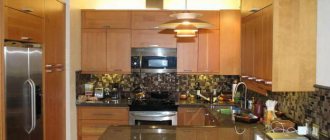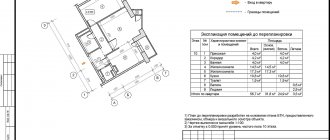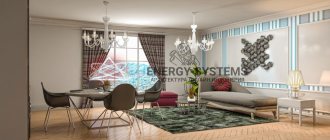Definition of “room”
Article 130 of the Civil Code of the Russian Federation identifies such types of real estate as residential and non-residential premises as independent objects of civil rights.
There is no definition of the concept of premises in the Civil Code of the Russian Federation. In clause 14, part 2, art. 2 of the Federal Law of December 30, 2009 N 384-FZ “Technical Regulations on the Safety of Buildings and Structures” contains the following definition:
room - part of the volume of a building or structure that has a specific purpose and is limited by building structures.
Initially, the definition of the concept of “premises” was given in the now repealed Federal Law of June 15, 1996 N 72-FZ “On Homeowners’ Associations”:
premises - a unit of a real estate complex (part of a residential building, other real estate object associated with a residential building), allocated in kind, intended for independent use for residential, non-residential and other purposes, owned by citizens or legal entities, as well as the Russian Federation, constituent entities Russian Federation and municipalities (Article 1 of the Federal Law of June 15, 1996 N 72-FZ).
It should be noted that this definition applied only to premises located in residential buildings or related real estate. Despite this circumstance, the definition that was given in the Federal Law “On Homeowners' Associations” most fully and correctly reflected the concept of premises and its meaning is suitable not only for premises located in residential buildings, but also for all other premises.
The Federal Law “On Homeowners' Associations” lost force on March 1, 2005 due to the adoption of Federal Law dated December 29, 2004 N 189-FZ “On the entry into force of the Housing Code of the Russian Federation”, and therefore its application for the official interpretation of the concept premises or for use as legislation applied by analogy is no longer permissible.
Minimum required premises in the house
Based on our experience and common sense, we recommend providing at least the following premises in the house:
- bedroom
- kitchen-dining room
- bathroom
- hallway.
If the size of the house allows (from 100 square meters), then we also recommend taking into account in the project:
- living room
- dressing room / pantry
- Utility room.
Other rooms can be provided in the house based on the wishes and capabilities of its owner.
Residential and non-residential premises
residential building , a part of a residential building, an apartment, a part of an apartment, a room as residential premises (Article 16 of the Housing Code of the Russian Federation).
Residential premises are isolated premises that are real estate and are suitable for permanent residence of citizens (meets established sanitary and technical rules and regulations, and other legal requirements) (Part 2 of Article 15 of the Housing Code of the Russian Federation).
The requirements for residential premises, the procedure for recognizing residential premises as suitable for living in and the grounds on which residential premises are recognized as unsuitable for living in are established by the Regulations on recognizing premises as residential premises, residential premises as unsuitable for living in and an apartment building as unsafe and subject to demolition or reconstruction, approved by Government Resolution Russian Federation dated January 28, 2006 N 47.
the concept of non-residential premises . At the same time, based on the definition of residential premises, non-residential premises should be understood as premises that are real estate and are intended for use for purposes not related to living in this premises (administrative, educational, industrial, medical, etc. premises) .
Considering that a premises is a part of a building or structure that is limited by building structures and has a specific purpose, any premises that is not residential, that is, not intended for permanent residence of citizens, is considered non-residential.
Non-residential premises in an apartment building - premises in an apartment building, indicated in the design or technical documentation for an apartment building or in the electronic passport of an apartment building, which is not a residential premises and is not included in the common property of the owners of premises in an apartment building... (paragraph 12 of paragraph 2 Rules for the provision of utility services to owners and users of premises in apartment buildings and residential buildings, approved by Decree of the Government of the Russian Federation of May 6, 2011 N 354).
Composition and layout of rooms
First, make a list of all the rooms that you really need. Not only bedrooms, but also technical rooms, bathrooms, halls, vestibule, boiler room. Here is a list of rooms that are usually in the house:
| Room name | Purpose |
| kitchen | in a private house, the kitchen is usually combined with the dining room |
| dining room | sometimes a small dining area is made in the kitchen, and a separate dining room next to it |
| summer dining room | terrace connected to the dining room or kitchen |
| kitchen-dining room | a popular option for combining kitchen and dining room |
| living room, hall | usually this is a room with upholstered furniture and a TV |
| fireplace | almost the same as the living room, but with a fireplace |
| common room | this is sometimes called a kitchen-dining-living room |
bedroom, dining room, guest bedroom, kitchen, toilet, guest toilet, winter garden, laundry/ironing room, pantry/closet, workshop... uh... . pool
Living room, Bathroom, Children's room, Dressing room, Office, Playroom..
laundry, dressing room, office, studio (relevant for artists, for needlewomen)
smoking room, basketball room, billiard room =) relaxation, sports =)
dark or mother-in-law's room.
Hall, dining room, for guests…
office, dressing room, laundry room, workshop, billiard room, gym - sports hall, children's room, tasting room, cinema room, winter garden - veranda - sun room, garden house.
- personal living quarters (bedroom, children's room);
- common living spaces (living room, dining room);
- personal hygiene rooms (bathroom, shower, toilet);
- utility rooms (kitchen, laundry room, ironing room);
- communication rooms (entrance hall, hall, corridor);
- rooms for storing clothes, shoes, etc. (storage room, dressing room);
- food storage facilities (cellar, food pantry);
- premises that ensure the operation of the house's engineering systems (boiler room, switch room, technical room);
- work/hobby rooms (office, workshop, games room, dance hall, billiard room);
- health and relaxation facilities (swimming pool, sauna, wash room, relaxation room, massage room);
- premises for service personnel (living quarters, bathroom).
You can also select premises for predominantly seasonal use:
- summer rooms (balconies, terraces, loggias, verandas);
- winter rooms (winter garden, fireplace room).
- A garage, like a swimming pool with a sauna, can be provided either directly in the house or designed as separate buildings.
As a rule, even before construction begins, the owner of the house knows who will live there and when. It is very important to accurately determine whether the house will be used all year round or, mainly, in the summer with trips on holidays and vacations. The requirements for a house for year-round use are much stricter, and such a house costs much more. If elderly people live in the house, you need to provide them with additional comfort, for example, a bedroom on the 1st floor, an automatic heating system, etc. Children require safe stairs and strictly environmentally friendly finishing materials. If guests stay overnight, they need a separate bedroom. Having thought through all these things, you can move on to the next stage.
Based on our experience and common sense, we recommend providing at least the following premises in the house:
- bedroom
- kitchen-dining room
- bathroom
- Utility room
- hallway.
If the size of the house allows, we also recommend taking into account in the project:
- living room
- dressing room
- pantry.
What rooms should be in a private house
What premises should be in a private house are dedicated to those who want to move from an apartment to a private house.
Living in a city apartment, a person somehow does not realize that his home can be a set of rooms with different functionality. What does a resident of a city apartment in a high-rise building see? Two or three rooms, a separate or combined bathroom, a kitchen of 9 or 12 square meters, a small corridor and a meager storage room.
To have a slightly different set of premises, you either need to pay an indecent amount of money at the stage of purchasing an apartment or immediately invest in building a studio apartment, and then cut it out and build partitions in your home to your taste.
When the time comes, and yesterday’s apartment dweller is ready to move for permanent residence to a city or country house, he faces a difficult choice.
It turns out that it is not enough to choose what material the house will be built from, what shape the roof will be, or what kind of boiler the house will be heated with. It is also necessary to plan the interior contents of the house, decide what rooms should be in a private house and how many there should be, as well as what area of the premises is optimal for his family. A house is a place that you are building for many years, and where your family will live. A house is a place that you are building for many years, and where your family will live.
This is where the factor of the third generation city dweller’s lack of experience in planning their living space comes into play. After all, when everything is decided for you, to the point that you first live in a one-room apartment, then move to a two-room apartment and then to the ultimate dream apartment - a three-room apartment, then where does the skill of independent planning come from?
A city dweller comes to a construction organization, where they offer him a standard project and say - your house will have 3 bedrooms, 2 bathrooms, the total area of the house will be 100 square meters. And a city dweller who has lived his adult life in a two-room apartment with a total area of 48 square meters immediately says “I’ll take it.”
The organization is building a house, everything is on schedule, the family goes to see how work is progressing at the construction site. Then, upon completion of construction, there is a ceremonial handing over of the house, champagne, flowers, a curtain. Construction is over, it's time to move in.
At first, the family is delighted, there is so much space, many rooms and even a staircase to the second floor, which in the city only local nouveau riche can afford in two-level apartments.
However, time passes and the family in a private house faces some inconveniences, which are called “real use of the house by living people.”
During this operation, points become clear that should have been thought about at the planning stage. Namely, what rooms should be in a private house, and where, and how they should be located. What rooms must be in a private house?
Without reference to specific quadratures, let's go through the composition of the premises in a modern private house. To understand what rooms and auxiliary premises are needed, let’s turn to the experience of using the house by real owners.
So first things first, the bedrooms. You can’t go anywhere without them, you have to sleep somewhere. How many bedrooms should there be in a house? The number of people living in it equals the number of bedrooms, minus one. A family of 4 people should have 3 bedrooms, a family of 3 people should have two. A family of two may not have a bedroom at all if they are young people. They can love each other in the living room, in the kitchen, and even in the hall. Great power is this love! But as soon as they have their first child as a result of this mutual love, they will immediately need a bedroom for themselves, and at least 1 children's room. You can’t do without a bedroom in a private house; the larger the bedroom area, the better. You can’t do without a bedroom in a private house; the larger the bedroom area, the better.
A house is not built for one year, which means it’s worth thinking about the future. Even if you just got married, plan one bedroom and 1 children's room, as well as 1 more room in reserve for a second children's room. And there’s no point in shirking, the country needs you, we need to raise the birth rate!
Next, the kitchen. She must be. How many meters it should be is another question. A house is not a home without a kitchen. If you like to cook at home and dine in the kitchen, then you should not make it less than 12-15 meters. It’s even better to make it 20 square meters.
And if you want to make a kitchen of 30 square meters, then think about whether it should be combined with the dining room.
Speaking of the dining room. If you regularly have friends or relatives of 5-8 people, then a dining room is vital for you. Because in the kitchen such a bunch of people who gather regularly will create a mess that is unpleasant to the owner’s heart.
Next, the bathrooms. If the house is two-story, then there should be two bathrooms in the house. One on the first floor, one on the second. If the house is three-story, then there should be three bathrooms. And so on. Did you catch the pattern? If your house has one floor and an area of 100 sq.m., then you can get by with one bathroom. And if the area of a one-story house is 200 square meters, then it is better to have 2 bathrooms. Bathroom in a private house - one for every 100 km. total area of the house. Bathroom in a private house - one for every 100 km. total area of the house.
Next are the utility rooms. You can’t do without storage rooms in a private home. Residents of apartments do not fully imagine that moment and do not include storage rooms of sufficient cubic capacity in the house design. But in vain. Without storage rooms in a private house there is nowhere. It is better to have a separate pantry for tools and supplies for home engineering systems, and a separate pantry where you can place a freezer, a second refrigerator or cabinets for non-perishable food.
And somewhere you need to store vacuum cleaners (one for each floor), brooms, rags, buckets, etc.
Let's move on to the boiler room. Some modern houses do not have a boiler room according to the design. This is fundamentally wrong. The boiler room is the heart of the house. She must be. It doesn’t matter which boiler heats your home, whether you heat it with electricity or your heat generator runs on diesel fuel. You should have a boiler room; it cuts you off from the noise of boiler equipment and serves the general safety of your home. Even a wall-mounted gas boiler is better placed in a separate boiler room. Even a wall-mounted gas boiler is better placed in a separate boiler room.
Of course, you can place a gas wall-mounted boiler in the kitchen. But the absence of a boiler room immediately makes the house a kind of ersatz.
And if you heat with a solid fuel boiler, then you can’t live without a boiler room.
Here is a set of the most typical rooms in a private house - 2-3 bedrooms, kitchen, dining room, bathrooms, 1-2 large storage rooms, boiler room. What rooms in a private house can you do without?
Now let's see what rooms in a private house you can do without. You can cut out the following premises, do not build them, do not include them in the estimate:
Laundry. Of course, she's comfortable. And many owners have a laundry room in their private home. But the washing machine can be placed in a large bathroom or in a utility room, in a pantry, where you can run cold water and a drain pipe. Office - library. This is due to excess funds. Of course, if your family loves to read, if you have collected several thousand books in your life, then you need to store them somewhere. However, if the question is about quickly moving from an apartment to a private house, then both the office and the library can be neglected. You can also neglect the cinema hall. That is, the place where there is a huge sofa with 10 seats and a simply indecently sized HD TV with a home theater. This place is the most interesting in the house, especially if you have a large package of satellite TV channels connected. But it’s quite possible to do without it. And, finally, there are halls on each floor where you can put fireplaces, where you can place armchairs, where you can sit in the winter cold by a live fire. It is quite possible to get by with compact corridors that will provide passage to the bedrooms or other rooms.
No comments yet
Click to cancel reply.
Signs of premises for cadastral registration purposes
To register for cadastral registration, the premises must simultaneously have two characteristics: isolation and isolation. The absence of at least one of these signs is a legal basis for refusal to carry out cadastral registration.
Isolation as a sign of a room is a spatial characteristic indicating that part of a building or structure is limited by building structures. At the same time isolation is a functional characteristic, reflecting the fact that the premises have an independent purpose, a separate entrance, and are not used for access to another premises, access to the common property of the owners of the premises in the building, and utilities.
For example, it is legal to refuse to register a premises for cadastral registration if this premises is used for access to another premises that has an independent purpose. This legal position is set out in paragraph 4 of the “Review of judicial practice in cases related to challenging the refusal to carry out cadastral registration”; approved By the Presidium of the Supreme Court of the Russian Federation on November 30, 2016. See the full text of paragraph 4 of the Review in the attachment below .
Types of premises in multi-apartment residential buildings
Depending on the purpose of the premises located in a multi-apartment residential building , they are distinguished (clauses 3.20 – 3.24 “SP 54.13330.2016. Code of rules. Residential multi-apartment buildings. Updated edition of SNiP 31-01-2003”):
- residential premises - an isolated premises, which is real estate and is suitable for permanent residence of citizens (meets established sanitary and technical rules and regulations, and other legal requirements).
- auxiliary room - a room for providing communication, sanitary, technical and household needs, including: kitchen or kitchen-niche, front room, bathroom or shower room, restroom or combined bathroom, pantry or utility built-in closet, laundry room, heat generator room and etc.
- common premises - non-residential premises for communication services of more than one residential and (or) non-residential premises, can be located horizontally along the floors (corridor, gallery), vertically between floors (staircase, staircase-elevator unit).
- public premises - a premises intended for carrying out activities in it to serve the residents of the house, residents of the adjacent residential area or for public and business activities, with an operating mode that does not have a harmful impact on living conditions in a residential building, having a separate entrance (entrances) with adjacent territory and (or) from a residential building, as well as other premises permitted for placement in residential buildings by Rospotrebnadzor authorities.
- technical premises - a non-residential premises intended for maintenance of in-house engineering systems, with limited access permitted to specialists of the operation services and specialists of the security and rescue services in emergency cases.
Server room
The server room is the brain of the building, the center of its telecommunications infrastructure. Data storage and processing servers, equipment for accessing external networks, local area network equipment, telephony, security systems, video surveillance, dispatching, clock registration, etc. are located here.
This equipment is expensive and requires the maintenance of special climatic conditions, as well as special safety measures. A huge number of cable routes come into the server room, which must be conveniently placed. Therefore, much attention is paid to the design of a server room.
building part
Each engineering subsystem in the server room has its own telecommunications cabinet (or several cabinets). For ease of maintenance, the cabinets are organized in rows, and each of them has two-way access: from the front and back. The server room houses climate control equipment, an uninterruptible power supply system and fire extinguishing system equipment. All this affects the area of the room and the required load-bearing capacity of the floor.
For laying cable routes, the room is equipped with a raised floor and a system of cable channels. With the help of special perforated tiles, the raised floor also provides the supply of cooled air directly to telecommunications cabinets, and thanks to the antistatic coating, it protects equipment sensitive to static electricity from failure.
Climate
Most modern equipment requires maintaining special climatic conditions for normal operation: a certain temperature and humidity.
The best solution is to equip the server room with precision air conditioners . They are specialized devices that can accurately maintain the required temperature and humidity all year round. But they are distinguished by their high cost, so to save money they often install split systems or, as a compromise, semi-industrial air conditioners.
As a rule, 100% redundancy of air conditioning power is used. This means that two air conditioners are installed, each of which is capable of completely providing the room with cold at any time of the year. Only one air conditioner always works, and the second is in hot reserve. Fifty percent reservation is also sometimes used. In this case, three units are installed, each of which has a power equal to half of the required one. Two units operate simultaneously, the third is a backup unit. With any redundancy, it is necessary to rotate operating units to ensure uniform wear and allocate time intervals for maintenance.
Electricity supply
Category I of power supply is required. To avoid loss of information during a short-term power failure, uninterruptible power supplies (UPS) must be provided. This is relevant for organizations and enterprises using information technologies, the stop of which will entail the loss of information or interruption of the management process. To increase the autonomy time in the event of a power outage or unacceptably low quality, you can equip the building with an automatic diesel generator set.
Safety
The server room is equipped with a fire alarm system and, very importantly, an automatic fire extinguishing system. It is possible to use a powder (cheaper) or gas (providing a minimum harmful effect on equipment) fire extinguishing system.
Types of premises in single-family residential buildings
Depending on the purpose of the premises located in a single-apartment residential building , they are distinguished (clauses 3.13 – 3.15 “SP 55.13330.2016. Code of rules. Single-apartment residential buildings. SNiP 31-02-2001”):
- residential premises - an isolated premises, which is real estate and is suitable for permanent residence of citizens (meets established sanitary and technical rules and regulations, and other legal requirements).
- public premises - premises built into a residential building or attached to it, intended for individual entrepreneurial and other public activities of people living in the house.
- parking space at the house - a built-in, attached or built-in-attached room for storing and (or) parking cars, not equipped for their repair and (or) maintenance, except for the simplest devices - sinks, inspection pits, overpasses.
What rooms must be in a private house?
Without reference to specific quadratures, let's go through the composition of the premises in a modern private house. To understand what rooms and auxiliary premises are needed, let’s turn to the experience of using the house by real owners.
So first things first, the bedrooms. You can’t go anywhere without them, you have to sleep somewhere. How many bedrooms should there be in a house? The number of people living in it equals the number of bedrooms, minus one. A family of 4 people should have 3 bedrooms, a family of 3 people should have two. A family of two may not have a bedroom at all if they are young people. They can love each other in the living room, in the kitchen, and even in the hall. Great power is this love! But as soon as they have their first child as a result of this mutual love, they will immediately need a bedroom for themselves, and at least 1 children's room.
A house is not built for one year, which means it’s worth thinking about the future. Even if you just got married, plan one bedroom and 1 children's room, as well as 1 more room in reserve for a second children's room. And there’s no point in shirking, the country needs you, we need to raise the birth rate!
The concept and types of premises in other regulations
premises are understood as buildings and structures, regardless of the form of ownership, intended for the temporary residence of people or the placement of material assets for production or other official purposes (clause 3 of the note to Article 158 of the Criminal Code of the Russian Federation).
Premises for temporary accommodation and residence - premises used for temporary accommodation and residence of individuals (apartment, room in an apartment, private house, cottage (parts thereof), hotel room, room in a dormitory and other premises) (paragraph 38 of article 346.27 Tax Code of the Russian Federation).
Premises with large numbers of people : halls and foyers of theaters, cinemas, boardrooms, meetings, lecture halls, restaurants, lobbies, cash registers, production facilities and other premises with an area of 50 m2 or more with permanent or temporary stay of people (except in emergency situations) more than 1 person per 1 m2. (clause 3.71 “SP 5.13130.2009. Fire protection systems. Automatic fire alarm and fire extinguishing installations. Design standards and rules”).
A room with permanent occupancy of people is a room in which people are expected to stay continuously for more than two hours (Article 2 of the Federal Law of December 30, 2009 N 384-FZ (as amended on July 2, 2013) “Technical Regulations on the Safety of Buildings and Structures” ).
List of useful documents
Documents for download:
| No. | Categories of premises according to fire hazard | Description |
| 1 | Premises fire hazard category A | Premises in which there are (circulate) flammable gases, flammable liquids with a flash point of no more than 28 degrees Celsius in such quantities that they can form explosive vapor-gas-air mixtures, upon ignition of which a calculated excess explosion pressure in the room develops exceeding 5 kilopascals, and (or ) substances and materials capable of exploding and burning when interacting with water, air oxygen or with each other, in such quantities that the calculated excess explosion pressure in the room exceeds 5 kilopascals. |
| 2 | Fire hazard category of premises B | Premises in which flammable dusts or fibers are located (circulated), flammable liquids with a flash point of more than 28 degrees Celsius, flammable liquids in such quantities that they can form explosive dust-air or steam-air mixtures, the ignition of which develops a calculated excess explosion pressure in the room exceeding 5 kilopascals. |
| 3 | Premises fire hazard category B | Premises in which flammable and low-flammable liquids, solid flammable and low-flammable substances and materials (including dust and fibers), substances and materials that can only burn when interacting with water, air oxygen or with each other are located (handled), provided that the premises in which they are located (handled) do not belong to category A or B. |
| 4 | Fire hazard category of premises G | Premises in which non-combustible substances and materials are located (handled) in a hot, incandescent or molten state, the processing of which is accompanied by the release of radiant heat, sparks and flames, and (or) flammable gases, liquids and solids that are burned or disposed of as fuel. |
| 5 | Premises fire hazard category D | Premises in which non-combustible substances and materials are kept (handled) in a cold state. |
Transfer of residential premises to non-residential and non-residential to residential
The legislation provides for the procedure and conditions for transferring residential premises to non-residential premises and non-residential premises to residential premises.
According to Part 1 of Art. 22 of the Housing Code of the Russian Federation, the transfer of residential premises to non-residential premises and non-residential premises to residential premises is permitted subject to compliance with the requirements of the Housing Code of the Russian Federation and the legislation on urban planning activities.
The transfer of residential premises to non-residential premises and non-residential premises to residential premises is carried out by a local government body (Part 1 of Article 23 of the Housing Code of the Russian Federation).
P. 5 part 2 tbsp. 23 Housing Code of the Russian Federation stipulates that for the transfer of residential premises to non-residential premises or non-residential premises to residential premises, the owner of the corresponding premises or a person authorized by him to the body carrying out the transfer of premises at the location of the transferred premises submits a reconstruction project prepared and executed in the prescribed manner and (or) redevelopment of the transferred premises (if redevelopment and (or) redevelopment are required to ensure the use of such premises as residential or non-residential premises).







